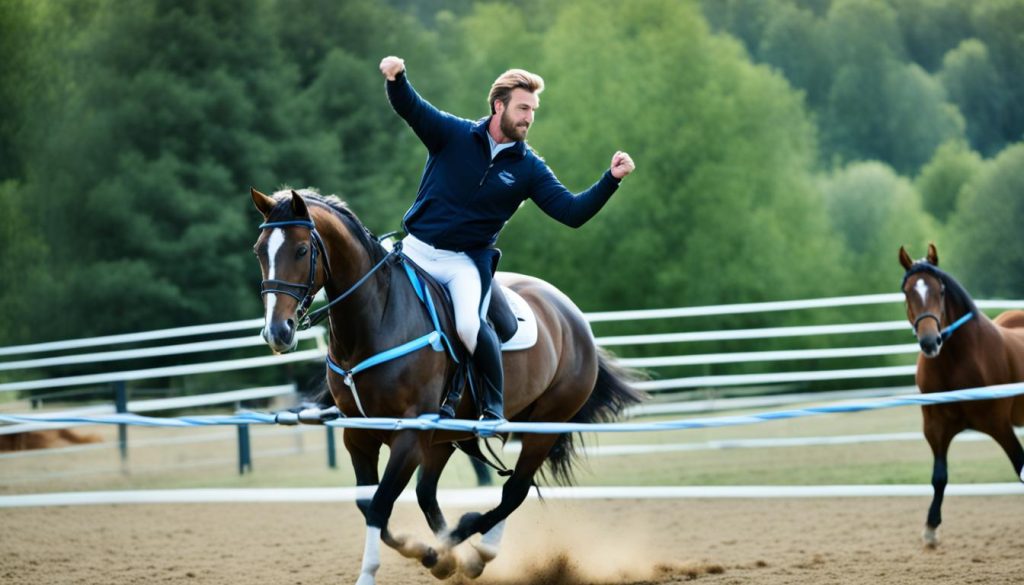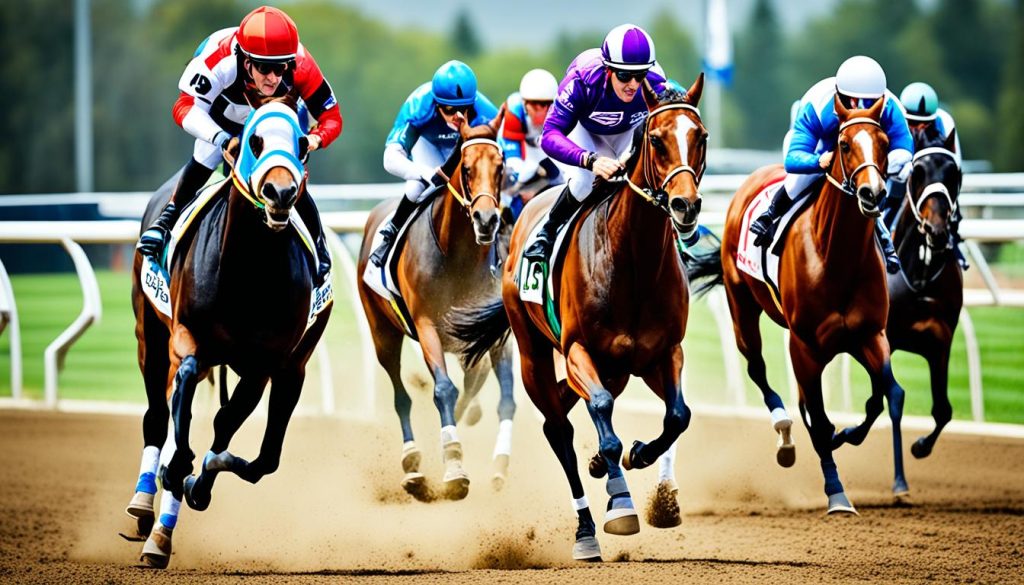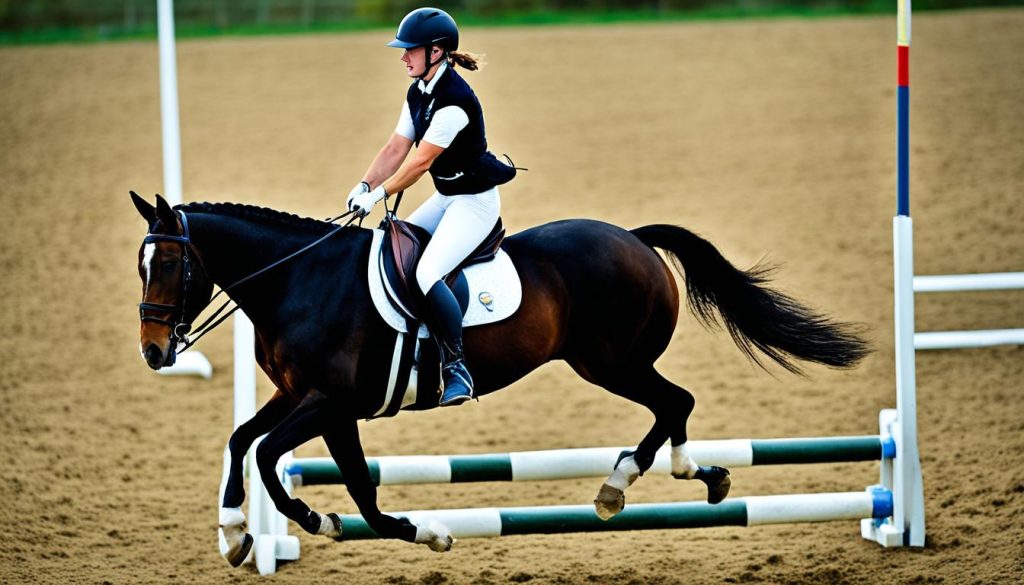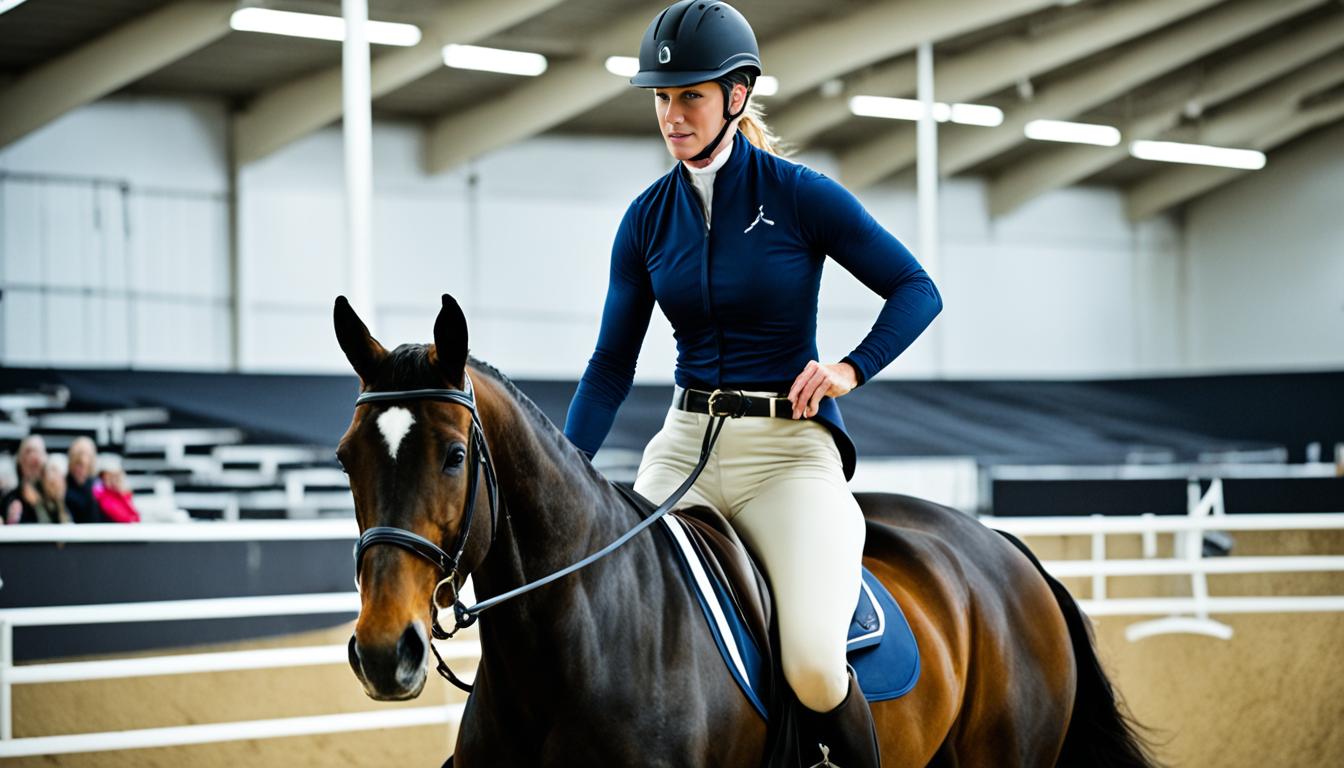Did you know that a well-structured training plan is crucial for maximizing a horse’s potential and reducing the risk of injury? Whether you’re a competitive rider or a leisure rider, having a training plan in place can make a significant difference in your horse’s performance and overall well-being.
Creating a training plan involves goal setting, competition scheduling, and choosing the right training focus and exercises. But it doesn’t stop there. It’s important to regularly assess and adjust the plan to ensure continued progress.
Key Takeaways:
- A well-structured training plan is essential for maximizing a horse’s potential and reducing the risk of injury.
- Training plans are beneficial for both competitive riders and leisure riders to track progress and strengthen the bond between horse and rider.
- Assessing the horse’s current fitness level and setting goals are important steps in creating an effective training plan.
- The Optimizing Equine Performance & Recovery Program offers online courses and in-person seminars to enhance equine professionals’ knowledge and impact.
- By following the steps to create an effective training plan and utilizing educational opportunities, horse owners and riders can elevate their horse’s performance to new heights.
Importance of a Training Plan for Every Rider
Training plans are not just for competition-ambitious riders but also for leisure riders who want to keep their horses healthy and fit. A well-structured training plan is essential for maximizing a horse’s potential, improving performance, and reducing the risk of injury. It provides a roadmap for progress, helps track achievements, and ensures that both horse and rider are consistently challenged.
Creating a training plan serves multiple purposes:
- Track progress: A training plan allows you to monitor the development of your horse and identify areas that require improvement. By keeping detailed records of each session, you can track milestones and celebrate achievements.
- Provide variety: A well-designed training plan incorporates a range of exercises and activities to prevent boredom and burnout. Mixing up your horse’s routine keeps them engaged and enthusiastic, while also targeting different muscle groups and skills.
- Prevent overexertion or under-exertion: With a training plan, you have a structured approach to managing your horse’s workload. It helps you avoid pushing your horse too hard, risking fatigue or injury, while also ensuring they receive enough exercise and stimulation to maintain their fitness.
- Strengthen the partnership: Consistency is key in building a strong partnership with your horse. When both horse and rider are following a structured plan, they develop a deeper understanding of each other’s capabilities and limitations, fostering trust and communication.
Crafting a training plan requires considering the individual fitness level, goals, and needs of your horse. A one-size-fits-all approach won’t yield the desired results. Take into account your horse’s age, breed, temperament, and any specific challenges they may have. Consult with a qualified trainer or equine professional to help tailor a training plan that aligns with your horse’s unique attributes and objectives.
Expert Insight: Renowned trainer Jane Smith shares her thoughts on the importance of a training plan:
“A well-structured training plan is the foundation for success in any equestrian pursuit. It not only helps riders achieve their goals but also ensures the long-term health and well-being of their equine partners. By understanding your horse’s needs, setting realistic targets, and consistently following a training plan, you establish a solid framework for progress and enjoyment.”
Steps to Create an Effective Training Plan
Creating a well-structured training plan is crucial for optimizing your horse’s performance and ensuring its overall health and well-being. By following these steps, you can design a training plan that supports your horse’s development and helps achieve your goals.
Assess the Horse’s Current Fitness Level
The first step in creating a training plan is to assess your horse’s current fitness level. This involves evaluating various factors, such as:
- Muscling
- Coordination
- Pulse rate
- Sweat patterns
By understanding your horse’s physical condition, you can tailor the training plan to its specific needs and abilities.
Set Goals for Strength, Conditioning, and Coordination
“Setting goals is a crucial part of any training plan. It gives you focus and something to work towards.” – Equestrian Champion
Once you have assessed your horse’s fitness level, it’s time to set specific goals that encompass strength, conditioning, and coordination. Consider what you want to achieve with your horse and what areas need improvement. These goals will serve as guideposts throughout the training process.
Plan the Training Approach
With your goals in mind, it’s important to plan the training approach that will help you reach them. This involves selecting the appropriate exercises and techniques that align with your horse’s current abilities and desired outcomes. A well-rounded training plan should include:
- General preparatory exercises
- Specialized preparatory exercises
- Specialized developmental exercises
- Competitive exercises
By incorporating these different types of exercises, you can ensure a comprehensive and well-rounded training program.
Implement the Training Plan and Regularly Reflect
With your training plan in place and exercises selected, it’s time to put it into action. Consistency is key when it comes to training, so make sure to adhere to the schedule and adjust as necessary based on your horse’s progress and response.
Regular reflection is also essential in evaluating the effectiveness of the training plan. Take the time to assess your horse’s performance, identify areas for improvement, and make any necessary adjustments to the plan. Training plans are dynamic and should be adaptable to meet your horse’s evolving needs.

| Steps | Benefits |
|---|---|
| Assess the Horse’s Current Fitness Level | – Tailor the training plan to the horse’s specific needs – Prevent overexertion or under-exertion |
| Set Goals for Strength, Conditioning, and Coordination | – Create focus and motivation – Measure progress accurately |
| Plan the Training Approach | – Ensure a well-rounded and comprehensive training program – Develop specific skills and techniques |
| Implement the Training Plan and Regularly Reflect | – Maintain consistency and progress – Adapt the plan based on performance |
The Optimizing Equine Performance & Recovery Program
The Optimizing Equine Performance & Recovery Program offers a comprehensive range of educational opportunities to enhance the level of care in the equine industry. Open to all equine professionals and equestrians, this program aims to provide important information on injury prevention, care, and rehabilitation, ultimately improving the knowledge, practical application, and impact of equine professionals.
The program consists of three levels, each offering valuable resources and training materials:
- Level 1: Online Series
- Level 2: In-person Seminar
- Level 3: Advanced Certification

Level 1: Online Series
The Level 1 of the Optimizing Equine Performance & Recovery Program is an online course designed as a prerequisite for further levels. This series consists of 14 sessions held over a 14-week period, covering a wide range of relevant topics in the equine industry. Students will receive comprehensive training materials, complete a written exam, and be awarded a Certificate of Completion upon successful completion of the course.
Level 2: In-person Seminar
After successfully completing Level 1, participants become eligible to register for the Level 2: In-person Seminar. This 4-day seminar focuses on practical application and hands-on experience, allowing participants to deepen their knowledge and refine their skills in the equine industry. By combining theory with real-life scenarios, this seminar offers a comprehensive learning experience to further enhance the impact of equine professionals.
Level 3: Advanced Certification
Level 3 of the Optimizing Equine Performance & Recovery Program is an advanced certification designed for equine professionals seeking to expand their expertise and make a significant impact in the industry. This level offers specialized training, advanced techniques, and in-depth case studies to further develop professionals’ skillsets, enabling them to provide superior care and rehabilitation to horses.
With the Optimizing Equine Performance & Recovery Program, equine professionals and equestrians have access to a comprehensive educational platform that enhances their knowledge, practical skills, and impact in the equine industry. By participating in this program and integrating its principles into their practice, participants can optimize performance and contribute to the overall well-being of horses.
Level 1: Online Series
Level 1 of the Optimizing Equine Performance & Recovery Program is designed to provide comprehensive training for equine enthusiasts and professionals alike. This online series consists of 14 engaging sessions that span over a 14-week period, offering in-depth knowledge and practical skills to enhance your understanding of horse training and conditioning.
The course covers a wide range of important topics in the equine industry, including training plans and schedules for horses, equine training programs, horse training regimens, equine exercise routines, horse fitness plans, horse conditioning schedules, equestrian training plans, equine workout plans, horse training calendars, and equine training techniques.
Throughout the online series, you’ll have access to detailed training materials that will support your learning journey. These materials are meticulously created to provide you with valuable insights and guidance on optimizing horse performance and recovery.

At the end of Level 1, you will take a written exam to assess your understanding and receive a Certificate of Completion. This certificate acknowledges your commitment to advancing your knowledge and skills in the equine industry.
Why Choose Level 1?
Level 1 serves as a prerequisite for Level 2 of the program and acts as a solid foundation for further learning and growth. By completing Level 1, you will have the necessary knowledge and expertise to progress to the next level.
“Level 1 of the Optimizing Equine Performance & Recovery Program provides a comprehensive online learning experience that empowers participants to enhance their understanding of training plans and regimens. By taking this course, you’re investing in your horse’s well-being and performance.”
– Sarah Thompson, Head Trainer at Equine Excellence
Gain a deeper understanding of Training Plans and Schedules for horses, Equine Training Programs, Horse Training Regimens, Equine Exercise Routines, Horse Fitness Plans, Horse Conditioning Schedules, Equestrian Training Plans, Equine Workout Plans, Horse Training Calendar, and Equine Training Techniques by enrolling in Level 1 of the Optimizing Equine Performance & Recovery Program today.
| Program Level | Delivery Method | Duration | Certificate |
|---|---|---|---|
| Level 1 | Online | 14 weeks | Yes |
Level 2: In-person Seminar
After successfully completing Level 1, you become eligible to register for Level 2 of the Optimizing Equine Performance & Recovery Program. This four-day in-person seminar is designed to provide practical application and hands-on experience, allowing you to deepen your knowledge and make a greater impact in the equine industry.
Unlocking Practical Skills and Expertise
The Level 2 seminar focuses on advanced equine training techniques, horse conditioning schedules, and equestrian training plans. Led by industry-leading experts, this immersive experience will enhance your understanding of equine exercise routines, horse fitness plans, and specialized developmental exercises. The seminar will give you the opportunity to refine your skills and explore new techniques to optimize horse performance and recovery.
Networking and Collaboration
Attending the Level 2 seminar provides you with invaluable networking opportunities. Connect with like-minded professionals, share experiences, and build relationships that can enhance your career and expand your knowledge. The collaborative environment encourages discussions, brainstorming, and learning from each other’s experiences.
Advancing to Level 3
Level 2 serves as a prerequisite for Level 3 of the program. By successfully completing the Level 2 seminar, you will have the knowledge, skills, and practical expertise needed to progress to the next level. Level 3 offers a comprehensive curriculum that delves deeper into equine training programs, horse conditioning schedules, and equestrian training techniques.
Continuing your journey with the Optimizing Equine Performance & Recovery Program is an investment in your professional growth and the well-being of your horses. By attending the Level 2 seminar, you will gain the necessary tools and insights to take your equine training endeavors to new heights.
Conclusion
Creating and following training plans and schedules for horses is crucial for optimizing their performance and ensuring their overall health and well-being. Whether you are a competitive rider or a leisure rider, implementing a well-structured training plan can help you track progress, prevent injury, and strengthen the bond between you and your horse.
The Optimizing Equine Performance & Recovery Program (OEPR Program) offers valuable resources for equine professionals and equestrians seeking to enhance their knowledge and impact in the industry. By following the steps to create an effective training plan and taking advantage of educational opportunities like the OEPR Program, you can elevate your horse’s performance to new heights.
Remember to consider equine training programs and regimens that suit your horse’s specific needs, whether it’s equine exercise routines, fitness plans, conditioning schedules, or workout plans. With proper equine training techniques and a horse training calendar, you can ensure that your horse not only performs at its best but also remains in top shape for a long and healthy life.
